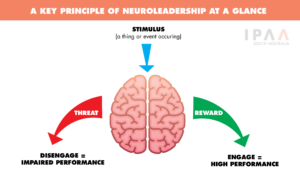What is Neuroleadership?
Neuroleadership draws its name from the idea of applying neuroscience principles to the field of leadership. Neuroscience is a multidisciplinary field that links psychology and neurochemistry to understand the intrinsic links between biological processes occurring in the nervous system to behavior and cognitive function.
Why do you need to know about Neuroleadership?
As a leader, you will have long puzzled with questions of “Why does my team act the way they do?”, “What is preventing me from being able to get my team on board with X, Y or Z?” or “What can be causing dysfunction in my team?” Neuroleadership sheds light on these kinds of questions, to explain behaviour and, in turn, suggest principles that will help us understand and positively modify the behaviour of ourselves and others.
How can it help you improve your ability to lead others?
Neuroleadership in particular lends itself to 4 areas of leadership which include: decision–making and problem–solving, emotional intelligence and regulation, collaboration and communication and leading others through change.
One of the core principles of neuroleadership is linked to the primitive structures of our brain chemistry for pleasure, reward and avoiding threats. This idea highlights that we all innately act in ways that minimise threat and maximise reward.

So, why does understanding these neuroleadership principles make you a better leader? In short, neuroleadership comes into its own at the organisational and team level – where our approach to management becomes more in-tune with the ‘human needs of staff’ to optimise engagement, performance, satisfaction and productivity. The core concept mentioned above flags an essential point of humanisiation for leaders and organisations – in the approach taken to change the way we perceive a stimulus in the environment. This means taking the stimulus which is producing a ‘threat’ response, and prompting us to disengage, and turning it into a ‘reward’ response, which engages us to perform at our best.
Creating a ‘Rewarding’ Environment
To get yourself and your team performing at their best, it’s vital to create an environment that puts your brain into the ‘reward state’ – where we are at our prime to make decisions and judgments, be innovative and be proactive with change. A ‘rewarding’ environment is one that recognises the ‘threats’ present in its culture and workplace. Workplaces that are constantly shifting goals and expectations, have poor communication or where people fear punishment for mistakes, creates a ‘threat state’ in our minds that cause us to disengage – with this presenting as impaired decision–making, poor mental recall and mental capability – to the extent that even routine tasks are impaired.
You can use neuroleadership tools to help shape your team and workplace into a rewarding environment by understanding and managing the neural processes that are leading to behaviours. This is where some expert advice will be essential – most leaders seek coaching and training on the area of neuroleadership to deepen this understanding and gain practical tools that can be deployed in the workplace.
If you want to start implementing neuroleadership principles to improve your own and your team’s performance, we hope to see you at our upcoming ‘Neuroleadership’ intensive half day course. During this course, you will work with an experienced psychologist and walk away with ways you can get the best from your team.
Register Now for ‘Neuroleadership’.
References
IPAA SA Neuroleadership Course Book, 2021.
Date
Thursday, 8 April 2021

